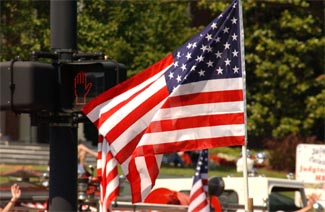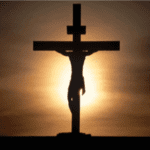Flag-Waving
by Geoffrey Biddulph

When the University of California-Berkley discouraged displays of the American flag at its Sept. 11 memorial, it was a sign that student leaders just didn’t “get it.”
The week before the one-year anniversary of the Sept. 11 terrorist attacks, the University of California-Berkeley announced it would actively discourage displays of the American flag in its memorial. Student leaders decided to distribute white ribbons, instead of red, white and blue.
Campus leaders said the American flag is a “symbol of U.S. aggression toward other countries” and were doing everything possible to discourage overt demonstrations of patriotism. The university later reversed its decision after world-wide protest, but the comments by campus leaders raises an interesting issue: does patriotism mean jingoism? By being overly nationalistic, are we encouraging violence against others?
Many of these issues have to do with the interpretation of symbols, and of course symbols play a key role in the gospel of Jesus Christ. And, perhaps surprisingly to some, the Book of Mormon has a lot to say about how symbols, including nationalistic symbols, are used in righteous societies.
We should not be confused about the intent of UC Berkeley’s campus leaders. They were very clear that they oppose U.S. nationalism. They nixed the singing of the “Star Spangled Banner” because it is too patriotic, divisive and political, as well as “God Bless America” because it mentions God.
“We thought that may be just too political, too patriotic,” said Hazel Wong, chief organizer for the Associated Students of the University of California. “We didn’t want anything too centered on nationalism-anything that is ‘Go U.S.A.'” Wong said the event organizers are “trying to steer away” from anything political, and that, she said, includes singing the National Anthem and displaying the red, white, and blue. She said they don’t want politics disrupting mourning and grieving.
The worldview of these campus leaders is very clear: they see the United States as a secular society that should avoid nationalistic displays. Nationalism, in their view, promotes violence, especially U.S. violence against smaller countries.
The campus leaders are certainly correct that symbols are important. As Latter-day Saints, we believe that God has given us a myriad of symbols to help us learn more about the plan of salvation. The scriptures tell us these symbols were used throughout history to help bring home the messages of the gospel.
Adam, the first man, was told to commit animal sacrifice after he was expulsed from the Garden of Eden. He did not know the reason for committing these sacrifices until an angel appeared and told him “this thing is a similitude of the sacrifice of the Only Begotten of the Father, which is full of grace and truth. Wherefore, thou shalt do all that thou doest in the name of the Son.” (Moses 5:7-8).
We see that animal sacrifices were performed until the coming of Jesus Christ to remind the people that one day they would sacrifice their own Savior. This symbolic performance was to remind them, again and again over thousands of years, of the single most important event in human history: the Atonement of Jesus Christ, which will allow all men and women to be saved.
Of course, mankind eventually forgot and distorted the purpose of sacrifice. It became a rote act without meaning for many people, and others instituted human sacrifice in a bizarre attempt to satisfy bloodthirsty pagan gods.
But with the perspective of history, and modern-day revelations, we can understand the importance of this symbolic ritual.
Similarly, the symbolic act of baptism has tremendous importance. Enoch revealed in the Book of Moses that Adam was baptized by the Spirit of God “and was carried down into the water, and was laid under the water, and was brought forth out baptized. And thus he was baptized, and the Spirit of God descended upon him, and thus be was born of the Spirit.” (Moses 6:64-65).
Why was Adam baptized? “For by water ye keep the commandment.” (Moses 6:60). Baptism by those with authority of God is a symbolic act that washes away the sins of the past. It involves the symbolic burial of the old, sinful person in water and the resurrection of a new, righteous person as the person is taken out of the water. Again, the symbolism points straight to Jesus Christ: just as Christ died and was resurrected, our old, sinful self can die and we can be resurrected as new people committed to God. Baptism is also intended to remind us that we all will be resurrected one day, thanks to the Atonement of Jesus Christ.
The scriptures are filled with reminders to the people of the importance of this rebirth in the water. Many of the ancient migrations involved crossing or traveling through or under water, and this is no accident. Moses’ parting of the Red Sea was intended to remind the people of Israel that they were being reborn as a new nation as they traveled underneath the water. Joshua’s parting of the Jordan River before the entry into Israel served the same purpose. The people of Lehi and the people of the Brother of Jared both had to travel over, and in some cases under, the water to be reborn in the promised land of the Americas. The flooding of the Earth in Noah’s time was a symbolic cleansing and baptism of our terrestial orb.
So, we can easily discern the importance of symbols. They are meant to teach us and remind us of greater issues.
The U.S. flag clearly has symbolic importance, as most national flags do. According to the Smithsonian, designs used by the colonies at first included parts of the Union Jack, the British flag. But on June 14, 1777, the Continental Congress declared, as a symbol of U.S. independence, that the flag should have 13 alternating red and white stripes with a union of 13 white stars in a blue field.
According to the Smithsonian’s web page: “In 1794, after Kentucky and Vermont joined the Union, Congress added two stars and two stripes. In 1818, when five more states had joined, Congress again changed the design to 13 stripes, representing the original 13 states, and 20 stars, with a provision that an additional star be added on the admission of each new state.” Now, we have 50 stars to represent the 50 states.
The colors of the flag are also important. Popular legends indicate that red is for valor, white for liberty or purity and blue for justice, loyalty and perseverance.
It is most definitely correct to see the American flag as a symbol of the United States. Its creation and history is filled with important representative reminders of American history.
U.S. fans waving the flag at the Olympics and other events are standing up for more than the flag. They are subscribing to an entire ideology that encompasses the history and significance of the American experience. They are saying that they are proud of that history and are expressing their allegiance once again to the United States as a national entity separate and distinct from other national entities.
Let us not think that Americans are alone in their nationalism. I am a U.S. citizen living and working in Brazil. Brazilians are equally proud of their flag. September 7 is independence day, for example, and many children are encouraged to attend school the day before in the national colors. When Brazil won the World Cup of soccer this summer, nearly every Brazilian carried a national flag for weeks.
I have been known to wave the Brazilian flag myself. I am extremely thankful to the country of Brazil for allowing me to live and work here for a time. I love the people of Brazil, and I have no problem agreeing with the national ideology, which is represented by Brazil’s flag. It does not offend me for a second for Brazilians to blatantly and aggressively express their nationalistic sentiments. On the contrary, I would be shocked if they were not proud of their country.
Interestingly, there is some flag waving that goes on in the Book of Mormon. In about 73 BC, the Nephites had created a mostly righteous society run by judges, but there was significant dissension. Some of the judges wanted a man named Amalickiah to become king, a coup d’etat that would change the governmental system and restrict personal freedom.
Moroni, the commander of the Nephite armies, became so upset at the evil machinations of Amalickiah and his supporters that he tore apart his coat and wrote upon it: “In memory of our God, our religion and freedom, and our peace, our wives and our children.” He placed his coat on a pole, put on his armor and prayed to God that freedom would be maintained in the land. Then he waved the flag to rally the people to his cause.
Moroni’s act of blatant patriotism was a signature event in the history of the Nephites. It helped them develop a national purpose and helped them remember what they believed in as a group. It gave them inspiration to defend their beliefs against those who wanted to destroy them.
But Moroni’s rent garment had an even deeper significance. As explained in Alma 46:23-27, his torn coat was intended to remind the people of Joseph’s torn coat of many colors in the Bible. Joseph’s brothers tore his coat into pieces after throwing him in the pit and selling him to slave traders. They brought it to his father Jacob and said Joseph had been killed. Jacob prophesied that a remnant of his people would be saved and taken to God, just as a remnant of Joseph’s garment was preserved. Moroni reminded the people of the Americas that they were a remnant of the seed of Jacob and had been preserved by God.
In a similar sense, the American flag has a greater meaning than many realize. The founding of the United States was deliberately planned by God to allow the conditions that would permit a restoration of the gospel of Jesus Christ. In the early 19th century, only the United States, founded on the uncompromising principle of religious liberty, had the environment where Joseph Smith could translate the plates and found the restored Church of Jesus Christ.
The Founding Fathers were, almost universally, devoutly religious people who daily petitioned God to help them in their struggle for independence against the most powerful country on Earth. It is no accident that some of the most brilliant and spiritually inspired people on the planet lived in the United States at the time of its founding. The Book of Mormon, compiled 1300 years before the founding of the United States, prophesied that in the latter days a mighty country of freedom would emerge: “And this land shall be a land of liberty unto the Gentiles, and there shall be no kings upon the land.” (2 Nephi 10:11).
Expressions of patriotism in America are a recognition of the special place that the United States holds in history. The devotion to the flag – from the stories about Betsy Ross to the “Star Spangled Banner” – are symbolic reminders of that great history.
So, in a sense, when we wave the U.S. flag on Sept. 11 or on any other day, we are not just performing a nationalistic act. We are celebrating something greater: the magnificence of God’s plan of salvation for all people.
It’s no wonder that those who believe the United States is a place where God should not be mentioned also oppose nationalistic symbols celebrating America. They are opposed to the entire package.
2002Meridian Magazine. All Rights Reserved.

















